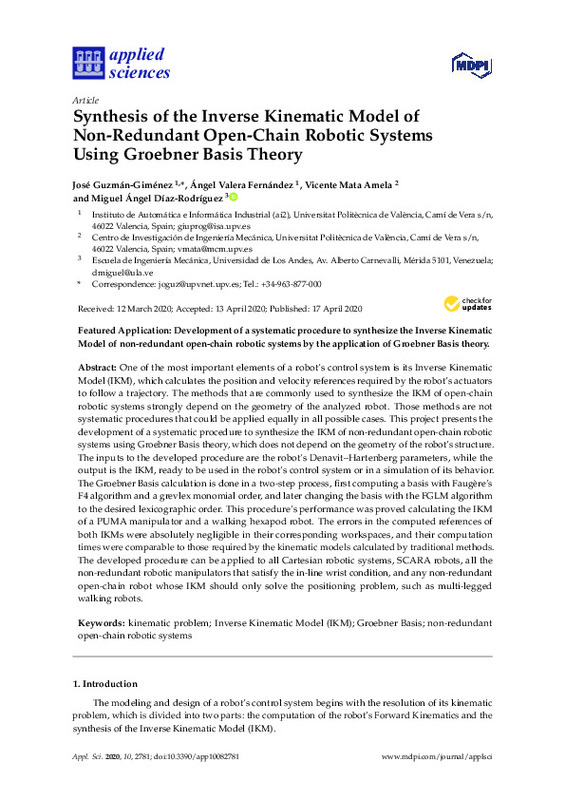Atique, M. M. U., Sarker, M. R. I., & Ahad, M. A. R. (2018). Development of an 8DOF quadruped robot and implementation of Inverse Kinematics using Denavit-Hartenberg convention. Heliyon, 4(12), e01053. doi:10.1016/j.heliyon.2018.e01053
Flanders, M., & Kavanagh, R. C. (2015). Build-A-Robot: Using virtual reality to visualize the Denavit-Hartenberg parameters. Computer Applications in Engineering Education, 23(6), 846-853. doi:10.1002/cae.21656
Özgür, E., & Mezouar, Y. (2016). Kinematic modeling and control of a robot arm using unit dual quaternions. Robotics and Autonomous Systems, 77, 66-73. doi:10.1016/j.robot.2015.12.005
[+]
Atique, M. M. U., Sarker, M. R. I., & Ahad, M. A. R. (2018). Development of an 8DOF quadruped robot and implementation of Inverse Kinematics using Denavit-Hartenberg convention. Heliyon, 4(12), e01053. doi:10.1016/j.heliyon.2018.e01053
Flanders, M., & Kavanagh, R. C. (2015). Build-A-Robot: Using virtual reality to visualize the Denavit-Hartenberg parameters. Computer Applications in Engineering Education, 23(6), 846-853. doi:10.1002/cae.21656
Özgür, E., & Mezouar, Y. (2016). Kinematic modeling and control of a robot arm using unit dual quaternions. Robotics and Autonomous Systems, 77, 66-73. doi:10.1016/j.robot.2015.12.005
Wang, X., Han, D., Yu, C., & Zheng, Z. (2012). The geometric structure of unit dual quaternion with application in kinematic control. Journal of Mathematical Analysis and Applications, 389(2), 1352-1364. doi:10.1016/j.jmaa.2012.01.016
Barrientos, A., Álvarez, M., Hernández, J. D., del Cerro, J., & Rossi, C. (2012). Modelado de Caden as Cinemáticas mediante Matrices de Desplazamiento. Una alternativa al método de Denavit-Hartenberg. Revista Iberoamericana de Automática e Informática Industrial RIAI, 9(4), 371-382. doi:10.1016/j.riai.2012.09.004
Virgil Petrescu, R. V., Aversa, R., Apicella, A., Mirsayar, M., Kozaitis, S., Abu-Lebdeh, T., & Tiberiu Petrescu, F. I. (2017). Geometry and Inverse Kinematic at the MP3R Mobile Systems. Journal of Mechatronics and Robotics, 1(2), 58-65. doi:10.3844/jmrsp.2017.58.65
Chen, S., Luo, M., Abdelaziz, O., & Jiang, G. (2017). A general analytical algorithm for collaborative robot (cobot) with 6 degree of freedom (DOF). 2017 International Conference on Applied System Innovation (ICASI). doi:10.1109/icasi.2017.7988522
Bouzgou, K., & Ahmed-Foitih, Z. (2014). Geometric modeling and singularity of 6 DOF Fanuc 200IC robot. Fourth edition of the International Conference on the Innovative Computing Technology (INTECH 2014). doi:10.1109/intech.2014.6927745
Mahajan, A., Singh, H. P., & Sukavanam, N. (2017). An unsupervised learning based neural network approach for a robotic manipulator. International Journal of Information Technology, 9(1), 1-6. doi:10.1007/s41870-017-0002-2
Duka, A.-V. (2014). Neural Network based Inverse Kinematics Solution for Trajectory Tracking of a Robotic Arm. Procedia Technology, 12, 20-27. doi:10.1016/j.protcy.2013.12.451
Toshani, H., & Farrokhi, M. (2014). Real-time inverse kinematics of redundant manipulators using neural networks and quadratic programming: A Lyapunov-based approach. Robotics and Autonomous Systems, 62(6), 766-781. doi:10.1016/j.robot.2014.02.005
Rokbani, N., & Alimi, A. M. (2013). Inverse Kinematics Using Particle Swarm Optimization, A Statistical Analysis. Procedia Engineering, 64, 1602-1611. doi:10.1016/j.proeng.2013.09.242
Jiang, G., Luo, M., Bai, K., & Chen, S. (2017). A Precise Positioning Method for a Puncture Robot Based on a PSO-Optimized BP Neural Network Algorithm. Applied Sciences, 7(10), 969. doi:10.3390/app7100969
Köker, R. (2013). A genetic algorithm approach to a neural-network-based inverse kinematics solution of robotic manipulators based on error minimization. Information Sciences, 222, 528-543. doi:10.1016/j.ins.2012.07.051
Rokbani, N., Casals, A., & Alimi, A. M. (2014). IK-FA, a New Heuristic Inverse Kinematics Solver Using Firefly Algorithm. Computational Intelligence Applications in Modeling and Control, 369-395. doi:10.1007/978-3-319-11017-2_15
Buchberger, B. (2001). Multidimensional Systems and Signal Processing, 12(3/4), 223-251. doi:10.1023/a:1011949421611
Kendricks, K. D. (2013). A kinematic analysis of the gmf a-510 robot: An introduction and application of groebner basis theory. Journal of Interdisciplinary Mathematics, 16(2-03), 147-169. doi:10.1080/09720502.2013.800304
Wang, Y., Hang, L., & Yang, T. (2006). Inverse Kinematics Analysis of General 6R Serial Robot Mechanism Based on Groebner Base. Frontiers of Mechanical Engineering in China, 1(1), 115-124. doi:10.1007/s11465-005-0022-7
Abbasnejad, G., & Carricato, M. (2015). Direct Geometrico-static Problem of Underconstrained Cable-Driven Parallel Robots With <inline-formula> <tex-math notation=«LaTeX»>$n$</tex-math></inline-formula> Cables. IEEE Transactions on Robotics, 31(2), 468-478. doi:10.1109/tro.2015.2393173
Rameau, J.-F., & Serré, P. (2015). Computing mobility condition using Groebner basis. Mechanism and Machine Theory, 91, 21-38. doi:10.1016/j.mechmachtheory.2015.04.003
Xiguang Huang, & Guangpin He. (2009). Forward kinematics of the general Stewart-Gough platform using Gröbner basis. 2009 International Conference on Mechatronics and Automation. doi:10.1109/icma.2009.5246088
Uchida, T., & McPhee, J. (2012). Using Gröbner bases to generate efficient kinematic solutions for the dynamic simulation of multi-loop mechanisms. Mechanism and Machine Theory, 52, 144-157. doi:10.1016/j.mechmachtheory.2012.01.015
Faugère, J.-C. (2010). FGb: A Library for Computing Gröbner Bases. Lecture Notes in Computer Science, 84-87. doi:10.1007/978-3-642-15582-6_17
Faugére, J.-C. (1999). A new efficient algorithm for computing Gröbner bases (F4). Journal of Pure and Applied Algebra, 139(1-3), 61-88. doi:10.1016/s0022-4049(99)00005-5
Faugère, J. C., Gianni, P., Lazard, D., & Mora, T. (1993). Efficient Computation of Zero-dimensional Gröbner Bases by Change of Ordering. Journal of Symbolic Computation, 16(4), 329-344. doi:10.1006/jsco.1993.1051
Salzer, H. E. (1960). A note on the solution of quartic equations. Mathematics of Computation, 14(71), 279-279. doi:10.1090/s0025-5718-1960-0117882-6
[-]









